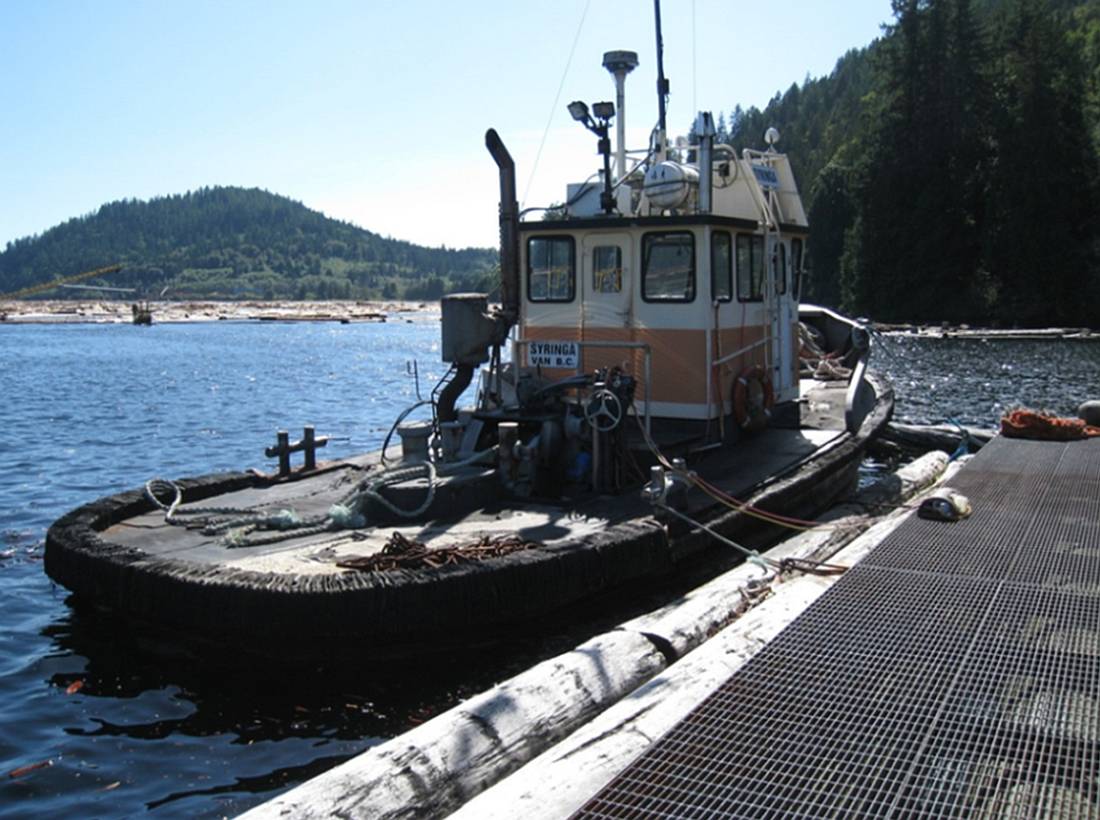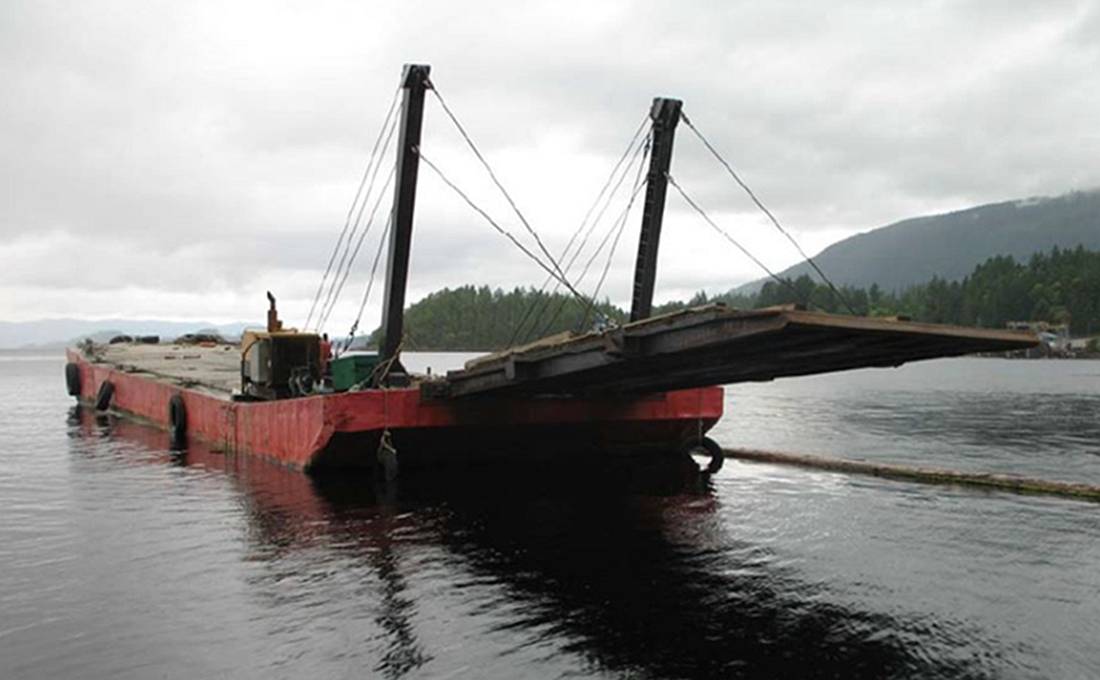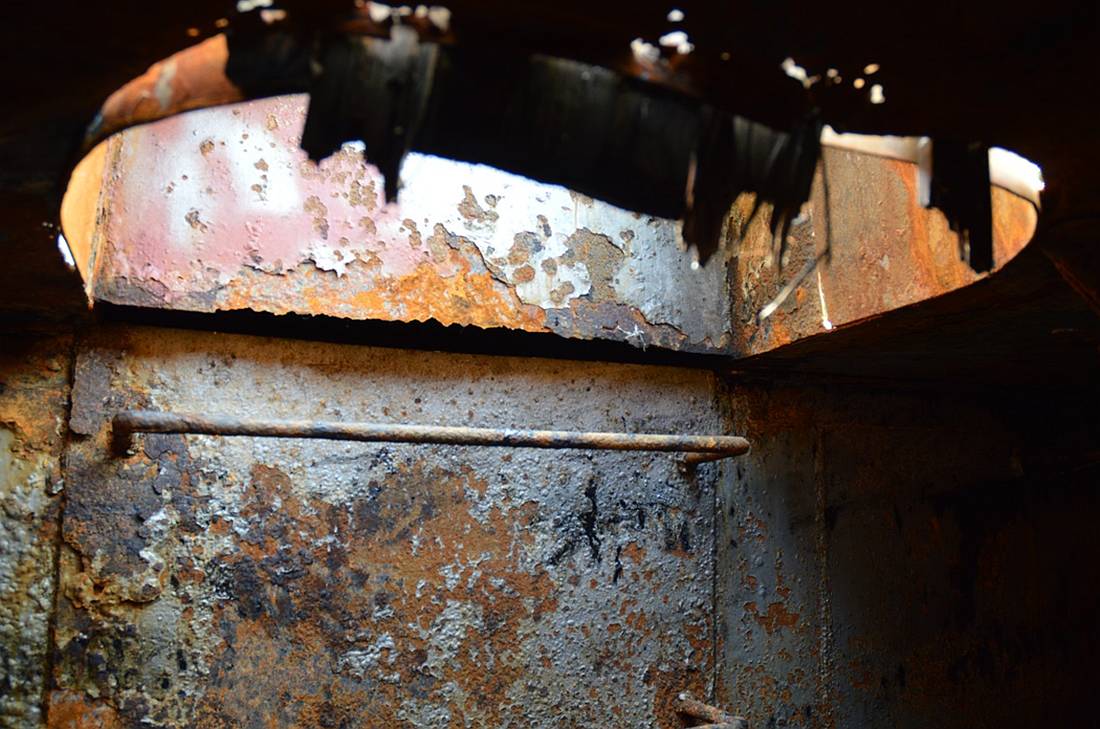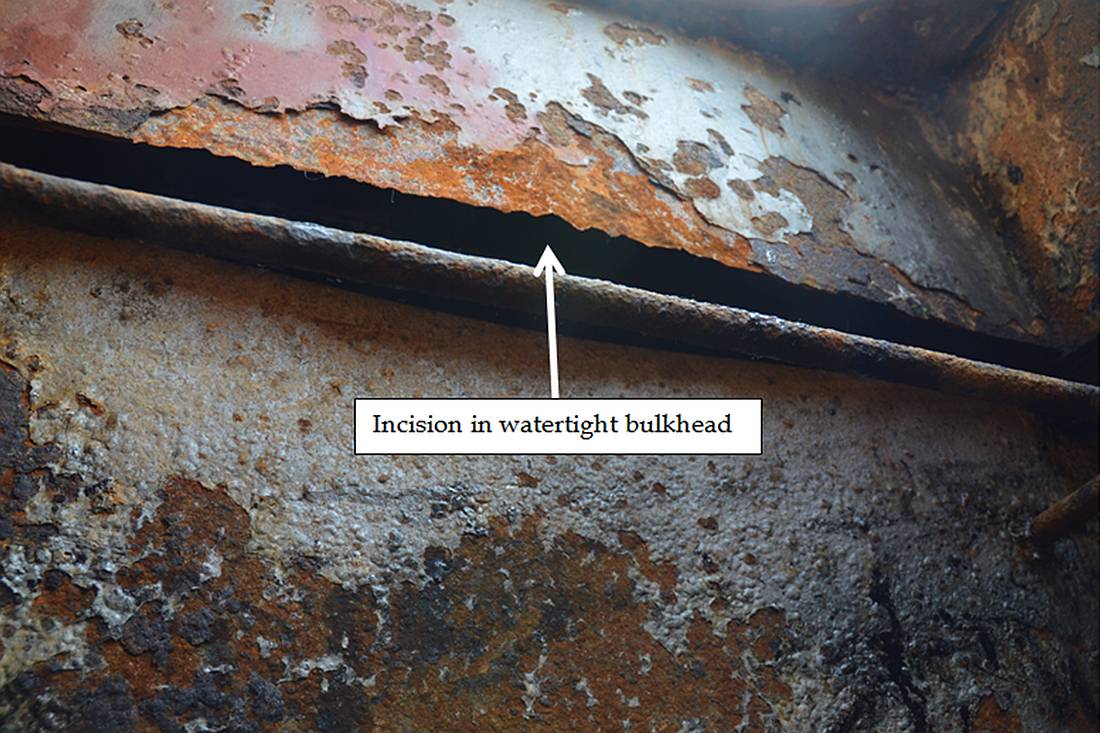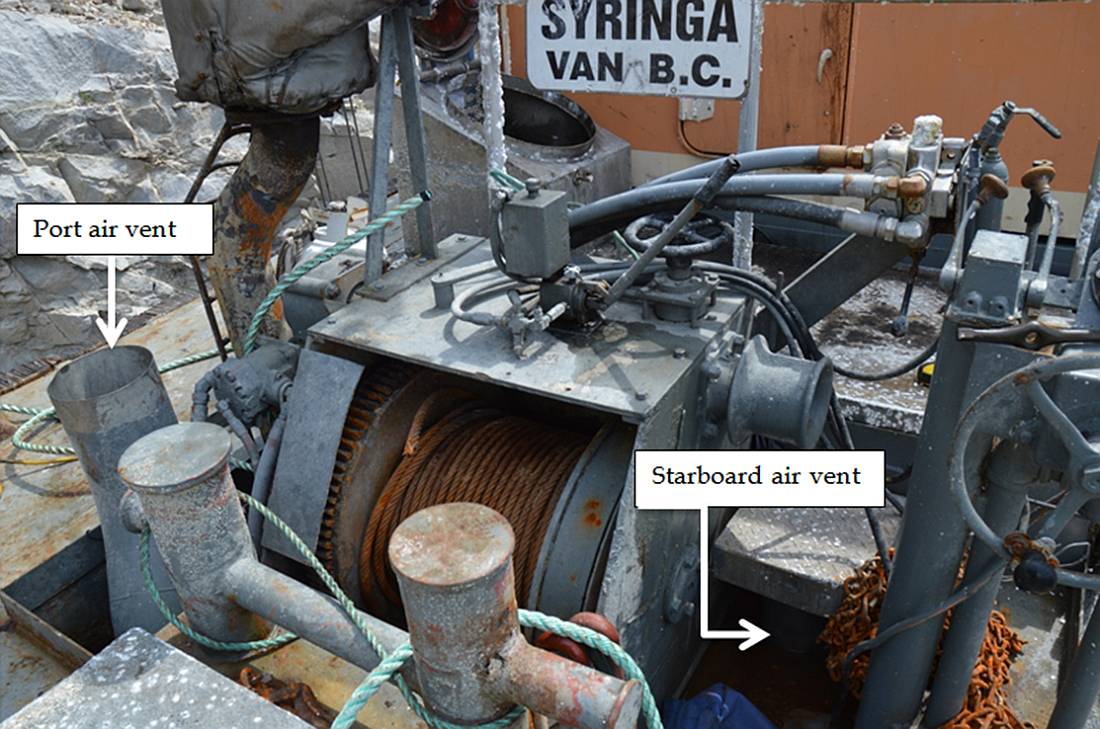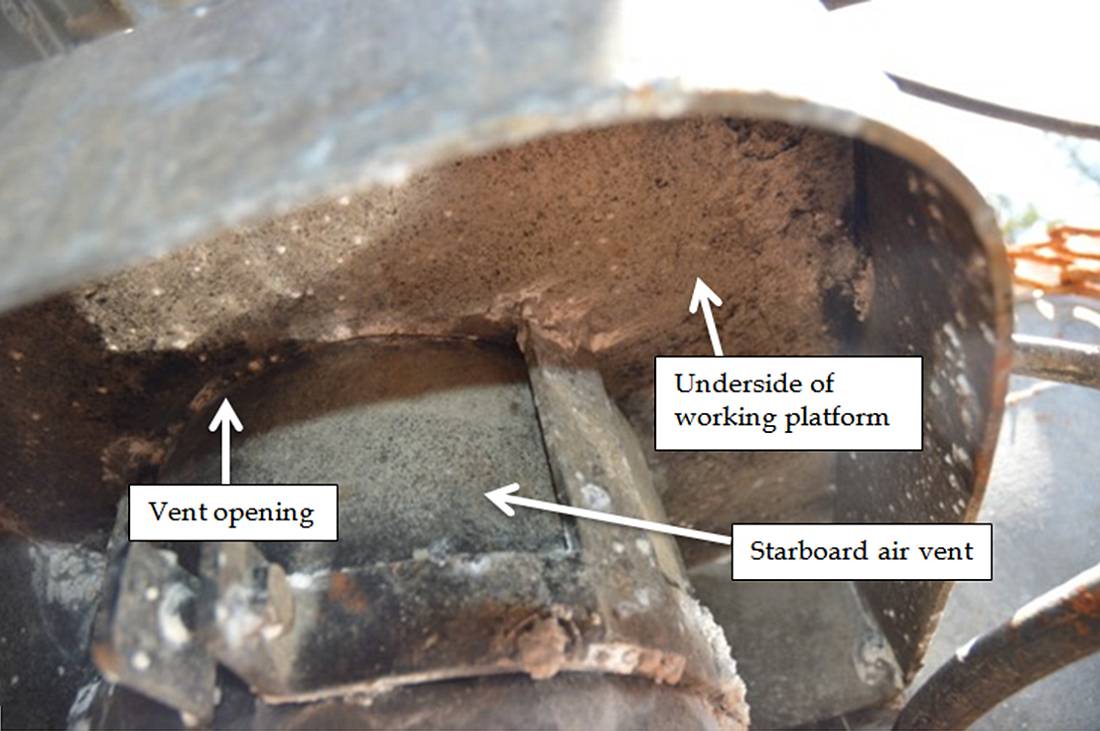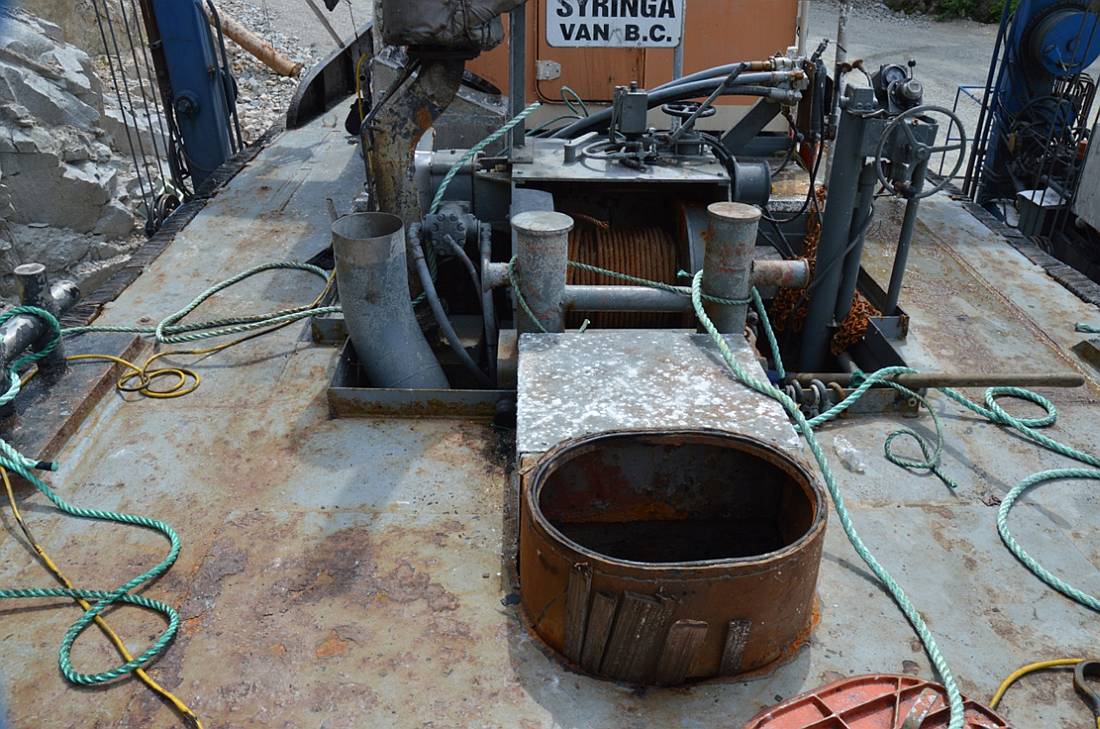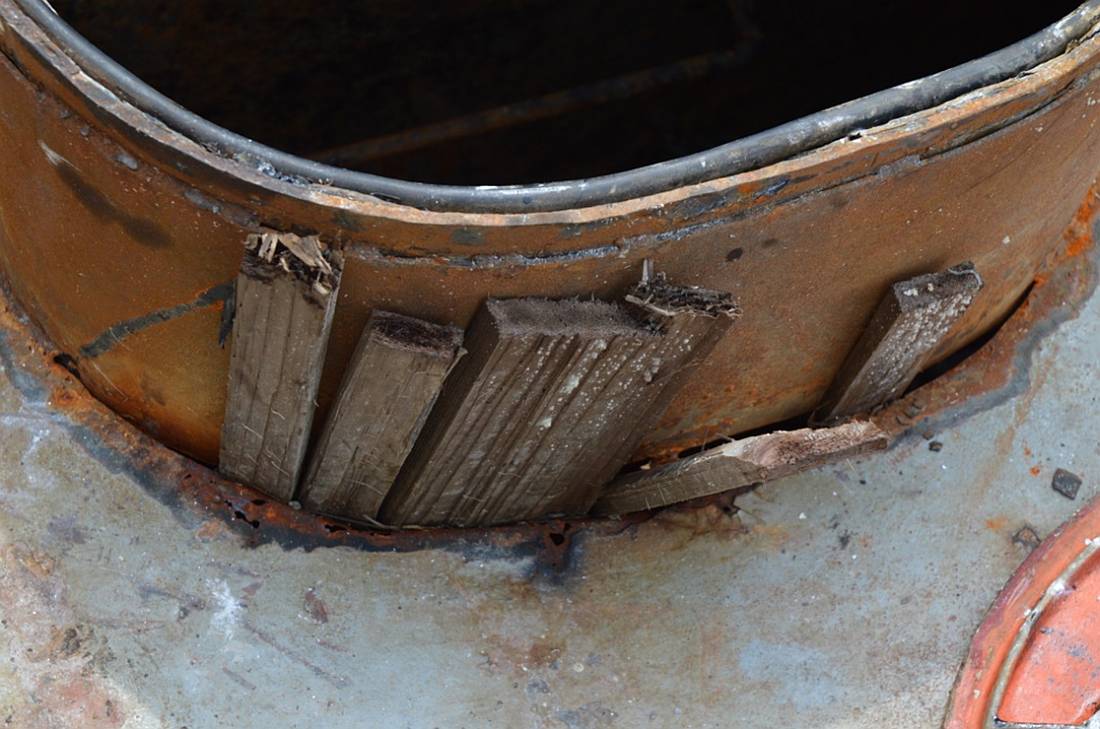Sinking
Tug Syringa
Off Sechelt, British Columbia
The Transportation Safety Board of Canada (TSB) investigated this occurrence for the purpose of advancing transportation safety. It is not the function of the Board to assign fault or determine civil or criminal liability. This report is not created for use in the context of legal, disciplinary or other proceedings. See Ownership and use of content. Masculine pronouns and position titles may be used to signify all genders to comply with the Canadian Transportation Accident Investigation and Safety Board Act (S.C. 1989, c. 3).
Summary
On 18 March 2015, at approximately 1541 Pacific Daylight Time, the tug Syringa took on water and sank about 40 metres north of Merry Island, off Sechelt, British Columbia. The tug had been towing the loaded barge Matcon 1 , which was released shortly before the sinking. The 2 crew members swam ashore and were later evacuated by the Canadian Coast Guard; no injuries were reported. A small quantity of diesel fuel was released from the tug after it sank, and the adrift barge was recovered by another tug.
Ce rapport est également disponible en français.
1.0 Factual information
1.1 Particulars of the vessels
| Name of vessel | Syringa | Matcon 1 |
|---|---|---|
| Official number | 313658 | 823135 |
| Port of registry | Vancouver, British Columbia | Vancouver, British Columbia |
| Flag | Canada | Canada |
| Type | Tug | Barge |
| Gross tonnage | 14.57 | 160 |
| Registered length | 10.85 m | 32.19 m |
| Draft at departure | 1.83 m | 1.52 m |
| Built | 1960 | 1945 |
| Propulsion | 1 diesel engine (250 kW) driving a fixed-pitch propeller | Non-propelled |
| Cargo | Tow | Construction equipment (an excavator, loader, trucks, and trailers), a tank of diesel fuel, and explosives |
| Crew | 2 | None |
| Registered owner | Spick & Sons Projects Ltd, Powell River, British Columbia | Private owner |
| Manager | Spick & Sons Projects Ltd, Powell River, British Columbia | Private owner |
1.2 Description of the vessels
1.2.1 Syringa
The Syringa is a single-screw, steel-hulled tug of closed construction built in 1960. It has a plumb stemFootnote 1 and rounded transom stern (Photo 1). A small aluminium wheelhouse is located on the fore part of the main deck, which is flush with no bulwark aft of the wheelhouse. The hull below the main deck is subdivided by 3 transverse bulkheads that enclose 3 compartments (from forward): the crew accommodation space, the engine room, and the lazarette.
The main deck is situated aft and is fitted with a single-drum towing winch located in a well. The winch is controlled locally and, in an emergency, the tow can be aborted from 3 locations: at the winch itself, inside the wheelhouse, and from atop the wheelhouse.
The wheelhouse can be accessed from the main deck via doors at the aft and starboard sides. It is equipped with a propulsion control console, a radar, an autopilot, an echo sounder, a global positioning system (GPS), and a very high frequency (VHF) radiotelephone with digital selective calling (DSC).
The engine room can be accessed through a hatch with a coaming located aft of the wheelhouse at the main deck level. It can also be accessed through the accommodation via a wooden door in the transverse bulkhead. Within the engine room are 2 diesel tanks of approximately 1893 litres each, arranged on the port and starboard sides. A single main engine provides propulsion, as well as hydraulic power for the towing winch.
The engine room is fitted with two 12-volt DC electric bilge pumps of approximately 7500 and 9500 litres per hour capacity. Within the wheelhouse, there is a visual indicator to show when the pumps are on, but no audible indicator. The bilge alarms in the engine room had been disconnected prior to the occurrence.Footnote 2 There are no bilge pumps in the lazarette.
The vessel's steering gear is located in the lazarette. The only access to the lazarette is through a hatch with a coaming on the main deck. When the tug had been under previous ownership, the lazarette had sustained flooding on a few occasions, but it had not caused the main deck to become submerged.
1.2.2 Matcon 1
The Matcon 1 is a steel barge with a flush concrete deck (Photo 2). The barge is registered under the name Matcon 1, but the owners also refer to it as the Jessie Ann and it has this name painted on the hull. The barge has a fore-and-aft centre bulkhead and is divided into 8 compartments. The cargo ramp, located forward, is controlled by hydraulically driven winches. Power for the hydraulics is supplied by a portable 4-cylinder diesel engine that drives the hydraulic pump.
1.3 Company operations
The tug Syringa and barge Matcon 1 were purchased by the current owners in 2013. The owners operate a construction company, and use the tug and barge to move construction material and equipment between various work sites. Both vessels are normally secured at Saltery Bay, British Columbia. In addition to the Syringa and the Matcon 1, the owners also own the John Alfred, a self-propelled landing craft of 21.49 m in length. They operated the John Alfred for approximately 5 years, but it has been out of service for the past 3 years because it requires re-powering.Footnote 3
Because work for the tug and barge is limited, they are contracted out to local companies when not being used by the owners. These contracts are usually arranged by the master. The owners rely on the master for the day-to-day operation and routine maintenance of the 2 vessels. For larger repairs or mechanical issues, the practice is for the master to request assistance from the owners; this is usually done by telephone. Larger repairs are generally carried out by one of the co-owners, who has performed welding jobs on construction equipment (excavators and dump trucks) and has done steel fabrication work for the company, but does not hold formal welding certification.
1.4 History of the voyage
On 13 March, following the completion of a voyage, the Syringa was tied up at Saltery Bay awaiting its next assignment. The master used this time to perform day-to-day maintenance, and contacted the owners by telephone to arrange repairs to a portion of the main deck plating in way of the lazarette coaming that was corroded and pitted. The co-owner with welding experience boarded the tug and began repairs to the deck plating. Meanwhile, an assignment transporting equipment from Valdes Island, British Columbia, to Hardy Island, British Columbia, was scheduled for 17 March. This assignment had been pending for several weeks.
On the evening prior to the Syringa's scheduled departure, the master observed a gap in the deck plating that had resulted from the repairs, which had not been completed. The gap was approximately 2.5 cm wide by 60 cm long in way of the lazarette coaming. The master temporarily patched this gap with cedar wedges and waterproof sealant. On the morning of 17 March, the tug took on approximately 3000 litres of fuel and 1890 litres of water and, at approximately 1200,Footnote 4 departed Saltery Bay with the barge Matcon 1 in tow. Manned by the master and a deckhand, the tug and barge arrived at Blackberry Point, British Columbia (Appendix A) at approximately 1600 and tied up to pilings for the night.
On 18 March at approximately 0800, the tug and barge proceeded to the Hardy Island Quarry on Valdes Island, where construction equipment, a tank of diesel fuel, and a magazine containing explosives were loaded onto the barge. At around 1000, the master commenced the passage to Blind Bay, British Columbia, with the tug pushing the barge ahead of it. The tug and barge had completed the transit through Dodd Narrows, British Columbia, by 1030 and were approaching the lee side of Snake Island, British Columbia.
As the tug and barge came up to Snake Island, the wind started to increase. The forecast was for 15- to 20-knot southeasterly winds so the master took a course through Welcome Pass, British Columbia, as it was a more sheltered route. He also switched from pushing mode to tow mode, so that the tug was now towing the barge using a 115-metre 3-strand synthetic tow line that was shackled to a chain bridle connected to the barge. The tow line was wound around the Syringa's tow post using figure-of-eight turns, and the loose end, which measured approximately 6 m, was left lying on the tug's deck.
The tug and barge headed for Merry Island, British Columbia, with the weather on the tug's starboard quarter. The winds were southeasterly at about 17 knots, and there was a 1 m swell which was causing the seas to break across the stern of the tug. Shortly after entering the Strait of Georgia, British Columbia, the tug began to ship water on the main deck, which is normal for tugs with low freeboards. The deckhand retired to the accommodation space.
When the tug and barge were approximately 1 nautical mile (nm) southwest of Merry Island, the master observed that the tug was behaving sluggishly. At 1522, he contacted the Marine Communications and Traffic Services Centre in Comox, British Columbia, at the regular calling-in position and advised that he would be slowing the tug in order to check on the tow. As the master slowed the tug, the stern started sinking until it was submerged under approximately 0.5 m of water. The master immediately alerted the deckhand and, at approximately 1530, they released the tow line and set the barge adrift.
The master returned to the wheelhouse and increased speed in order to beach the tug on Merry Island, but the tug continued to sink further by the stern. When water began to enter the wheelhouse, the master instructed the deckhand to go to the bow of the vessel, as it was the highest point on the deck. The master continued to steer the vessel toward the island while holding the starboard-side wheelhouse door open. As the water level in the wheelhouse rose, the master asked the deckhand to hold the starboard-side door open, and the deckhand complied. At approximately 1535, when the water inside the wheelhouse was about 1 m deep, both the master and the deckhand jumped into the water without donning lifejackets or exposure suits. The engine was still running when the crew abandoned the vessel.
The tug Syringa sank approximately 40 m from the north tip of Merry Island, in position 49°28.31′ N, 123°55.40′ W. At this location, the water depth was about 14 to 16 m. After the tug sank, the 4-person life raft floated free from its deep chocksFootnote 5 on top of the wheelhouse. The master and the deckhand held on to the life raft and attempted to inflate it from the water by tugging on the painter approximately 5 times. Unsuccessful in their attempt, the master and the deckhand abandoned the life raftFootnote 6 and swam for shore because of their proximity to the island.
At 1537, a person ashore made a 9-1-1 call advising that a tug had sunk, and the Joint Rescue Coordination Centre (JRCC) in Victoria was subsequently notified. JRCC tasked several search and rescue units, including the Canadian Coast Guard Hovercraft Siyay.
At approximately 1545, both the master and the deckhand reached the shore at the northern tip of Merry Island and walked to the lighthouse, arriving at about 1615. The lighthouse keeper provided them with assistance until 1700, when the Siyay arrived and transported the master and deckhand to Gibsons Landing, British Columbia. At 1839, the adrift barge Matcon 1 was recovered by the tug Helen J and towed into Blind Bay. The Syringa was salvaged 2 months after the occurrence.
1.5 Environmental conditions
The weather at the time of the occurrence was overcast. The visibility was approximately 6 nm, and the wind was southeasterly at 17 knots. There was a southeast swell of approximately 1 m, and the water temperature was 9.1°C.
1.6 Damage to the tug
There was significant saltwater contamination of the machinery, fuel and hydraulic piping systems, navigation equipment, electrical systems, and accommodation fittings. The vessel was declared a constructive total loss by the insurers.
1.7 Personnel certification and experience
The master started his marine career in 1973 working on coastal vessels and had been performing the duties of master since 1984. The master had held a Master Limited certificate issued in 2005 that was valid for tug boats of not more than 15 gross tons (GT) operating in Howe Sound and Strait of Georgia between Sechelt and Point Grey within 5 nm from shore. At the time of the occurrence, this certificate was expired and the geographical limitations on the certificate had been exceeded. The master had been employed by the current owners of the vessel in the capacity of a master since 2009, and had been operating the Syringa for the last 2 years.
The deckhand was a casual worker and was only employed by the company when the vessel was operating. The deckhand did not hold any marine certificates and had not received marine emergency duties (MED) training.
The owners, who are also the authorized representatives (AR)Footnote 7 for the Syringa, had limited experience managing commercial vessels. They had no seagoing experience other than on pleasure sailboats.
1.8 Regulatory oversight
In Canada, tugs less than 15 GT are not required to be certificated or inspected by Transport Canada (TC) under the current Hull Inspection Regulations or Vessel Certificates Regulations. Consequently, these tugs are not issued any voyage limitations, nor are they provided guidance with respect to manning levels in the form of a minimum safe manning document.Footnote 8 TC Marine Safety inspectors have the authority to conduct random monitoring inspections to verify compliance with the Canada Shipping Act, 2001 (CSA 2001). There are no records to indicate whether the Syringa had ever been subject to a random monitoring inspection by TC.
There are approximately 821 steel-hulled tugs less than 15 GT registered in British Columbia. These tugs are not part of a structured inspection cycle, though TC has inspected a few of them following reported occurrences/incidents.
In comparison, there are approximately 228 tugs greater than 15 GT registered in British Columbia. These tugs are required to be inspected prior to being certificated and then again periodically by TC under the current Hull Inspection Regulations or Vessel Certificates Regulations. As part of the inspection process, tugs in this class are issued voyage limitations and/or limitations with respect to the weather conditions and/or type of activity (e.g., towing) for which the vessel is used. Tugs greater than 15 GT are also provided guidance regarding manning levels in the form of a minimum safe manning document. The minimum safe manning document specifies the number of crew required to safely operate a vessel, as well as their qualifications.
1.8.1 Tug inspection requirements in the United States and the United Kingdom
The United States is in the process of making changes to their regulatory regime for towing vessels. In 2011, a Notice of Proposed Rulemaking (NPRM) was published that includes the following amendments:
- add towing vessels as a class of inspected vessels (≥ 26 feet);
- establish a requirement for safety management systems on towing vessels;
- prescribe intervals for drydock and internal structural examination;
- prescribe maximum hours of service for individuals on towing vessels;
- prescribe qualifications for third-party auditors and related procedures; and
- prescribe procedures for vessel compliance and obtaining a certificate of inspection.Footnote 9
The United States Coast Guard is currently working on addressing public comments on the NPRM, and the Final Rule is expected to be published in 2016.
In the United Kingdom, small workboats (which include tugs) engaged in commercial activity are regulated under The Merchant Shipping (Small Workboats and Pilot Boats) Regulations, 1998 and the Small Workboat Code (Brown Code). Under these regulations, vessels under 24 m in length or less than 150 GT are required to undergo inspection by the certifying authority. A successful inspection results in issuance of a certificate valid for not more than 5 years. In addition to the above, vessels are subject to annual and intermediate examinations conducted out of the water by an authorized person from the certifying authority.
1.8.2 Transport Canada Small Vessel Compliance Program
TC launched the voluntary Small Vessel Compliance Program (SVCP) in June 2011, as one way for ARs to pursue regulatory compliance. The SVCP is available for vessels that are less than 15 GT, carry 12 passengers or less, and are not pleasure craft. The program provides owners with tools, guidelines, and related documents to help them ensure their vessels are in compliance with the applicable regulations.
To participate in the SVCP, owners must enroll individual vessels. Once enrolled, TC Marine Safety prioritizes vessel monitoring based on risk assessments of the vessels enrolled in the program.
The program is available to vessels registered as passenger vessels and workboats, but there are currently no provisions to enroll vessels registered as tugs less than 15 GT. SVCP-T, which is specifically for tugs, is currently under development by TC, and implementation is expected to begin in 2016.
1.9 Lifesaving appliances and emergency drills
The Syringa carried a 4-person life raft that was placed in deep chocks, without lashings, on top of the wheelhouse. The painter was 28 m in length and had a weak link. The life raft had last been serviced in April 2013 by the previous owners of the vessel. The Life Saving Equipment Regulations require the life raft on the Syringa to be serviced annually.
The Syringa also carried 2 lifejackets and 2 exposure suits, which were stowed in the accommodation space.Footnote 10 Two life buoys were lashed to the vessel on either side of the wheelhouse, and the vessel carried fire extinguishers and emergency flares. The vessel was not equipped with an emergency position-indicating radio beacon (EPIRB), and nor was it required by regulation.
There were no procedures on board the vessel to deal with emergencies, and the crew did not participate in emergency drills.
1.10 Vessel modifications
The Syringa had undergone the following modifications under previous ownership:
- The original steel wheelhouse was replaced with a smaller aluminum wheelhouse in 2006.
- A new diesel engine was installed around 1998.
- SponsonsFootnote 11 were installed on the port and starboard sides of the hull.
- An incision (approximately 270 mm by 100 mm) was made in the watertight bulkhead between the lazarette and the machinery spaces at main deck level for ventilation purposesFootnote 12 (Appendix B).
- The starboard-side engine room vent, which is located in the winch well, was cropped at deck levelFootnote 13 to accommodate a working platform. The platform was installed on the vent opening without a sealing arrangement (Appendix C).
TC requires that, when a vessel undergoes modifications, the owner of the vessel must report these modificationsFootnote 14, and TC may require the vessel to undergo a stability assessment.Footnote 15 The Syringa had undergone modifications under the previous owners, but these modifications had not been reported to TC and the vessel had not been assessed for stability.
The current owners were not aware of the alterations to the hull or the disconnected bilge alarms, and these two items had not been identified during the insurance survey conducted for the underwriters when the vessel was purchased.
1.11 Post-occurrence examination of the vessel
The Syringa was examined by TSB investigators on 22 May 2015, the same day that it was hauled out of the water. The following observations were made:
- The hull appeared intact based on a visual examination, and there was between 30 and 45 cm of water at the bottom of all of the compartments.
- There was a gap (measuring approximately 2.5 cm by 60 cm) in the deck plating, in way of the lazarette coaming, with 6 cedar wedges in it (Appendix D).
- The starboard-side sponson had cracks and was leaking water after salvage.
- Water in the towing winch well was draining freely from the port-side drain, but was not draining from the starboard-side drain.
- A wooden door without seals was located in the transverse bulkhead between the accommodation and machinery spaces.Footnote 16
- Cables and pipes that ran from the deck, through the winch well and into the machinery space, passed through glandsFootnote 17 that had no seals.
- The presence of debris and oily water in the bilges precluded investigators from observing the automatic bilge pumps located in the engine room and determining their effectiveness.
1.12 Vessel management
Under the CSA 2001,Footnote 18 the AR is responsible for:
- ensuring the vessel and its machinery and equipment meet the requirements of regulations set out by the CSA 2001;Footnote 19
- developing procedures for the safe operation of the vessel and for dealing with emergencies; and
- ensuring that the crew receive safety training.
Supporting documentation and records must be available to any person or organization authorized under the CSA 2001 to carry out inspections.
TC has also developed the following 2 guidance documents to help with the safe operation of tugs:
- Guidelines for the Construction, Inspection, Certification, and Operation of Tugs < 24 Meters in Length (TP15180)
- Small Commercial Vessel Safety Guide (TP14070)
1.13 Safety management system
The principal objective of a safety management system (SMS) on board a vessel is to ensure safety at sea, prevent human injury or loss of life, and avoid damage to property and the environment. Safety management involves individuals at all levels of an organization and requires that a systematic approach be taken in the identification and mitigation of operational risks.
Some elements of an effective SMS include the following:
- operating procedures for the vessel and the use of checklists;
- maintenance procedures for the vessel and its associated equipment;
- documentation and record keeping procedures;
- procedures for identifying hazards and managing risks;
- procedures to prepare for, and respond to, emergency situations; and
- drills, training, and familiarization for the vessel's crew.
The Syringa did not operate under an SMS, nor was it required to by regulations.
In 2010, TC began formal consultations on a regulatory proposal to introduce safety management regulations to Canadian non-convention vessels, including those less than 15 GT. However, industry expressed concerns, primarily concerning costs and feasibility, that the new regulations would be too onerous for small companies that operate small vessels to implement. In response to stakeholders' concerns, TC amended its regulatory proposal in 2012 to include only vessels greater than 24 metres in length and those carrying more than 50 passengers.
At the National Canadian Marine Advisory Council (CMAC) meeting in November 2014, TC updated industry on the proposed Safety Management Regulations, which would now apply to 3 groups of vessels and the companies that manage them:
- Tier I includes International Convention for the Safety of Life at Sea (SOLAS) convention vessels.
- These vessels will continue to be required to meet the existing requirements of the International Safety Management (ISM) Code, including audit and certification.
- Tier II includes non-SOLAS convention vessels of 500 GT and upwards and vessels that are certified to carry more than 50 passengers.
- These vessels will be required to have SMS in accordance with the ISM Code, including audit and certification.
- Tier III includes vessels that are not subject to SOLAS that are 24 m or more in length and less than 500 GT (excluding vessels certified to carry more than 50 passengers).
- These vessels will be required to have SMS, but will not be required to have their SMS audited and certified.
These proposed changes would not apply to tugs the size of the Syringa.
1.14 Previous occurrences
Between January 2010 and November 2015, the TSB received reports of 14 other occurrencesFootnote 20 in British Columbia involving tugs less than 15 GT that sank or capsized.
1.15 TSB Watchlist
1.15.1 Safety management and oversight is a 2014 Watchlist issue.
The Watchlist is a list of issues posing the greatest risk to Canada's transportation system; the TSB publishes it to focus the attention of industry and regulators on the problems that need addressing today.
The TSB has identified safety management and oversight as a Watchlist issue. As this occurrence demonstrates, some transportation companies are not effectively managing their safety risks. The solution will require all operators in the marine industry to have formal safety management processes, with oversight by TC. When companies are unable to effectively manage safety, TC must not only intervene, but do so in a manner that succeeds in changing unsafe operating practices.
2.0 Analysis
2.1 Events leading to the sinking
The Syringa departed Saltery Bay, British Columbia, with a gap in the deck plating as a result of repairs that were not completed. The master had temporarily filled the gap using cedar wedges and sealant prior to departure.
During the transit through the Strait of Georgia, British Columbia, the tug shipped water on deck for approximately 3 hours. The shipped water sloshing about on deck, possibly in combination with the loose end of the tow rope, likely caused some of the cedar wedges and sealant to become dislodged, allowing water to enter the lazarette. As the lazarette filled up, the vessel began to sink by the stern. Once the lazarette was flooded, water could subsequently enter the engine room through an incision in the watertight bulkhead between these 2 spaces. Water could also enter the engine room via the cable glands in the winch well and the cropped starboard-side air vent, once these were submerged, as neither were protected against water ingress.
The high-level bilge alarms for the engine room had been disconnected at some point prior to the occurrence, and the investigation was unable to determine the effectiveness of the 2 electric bilge pumps that serviced the engine room. The tug and tow were not being monitored for water ingress during the voyage, and the master had no indication of the flooding until it began to affect the vessel's movement. Shortly after the master became aware of the flooding, the vessel lost all reserve buoyancy and sank. The 2 crew members abandoned the vessel into the water and managed to swim to shore without the assistance of lifesaving equipment or a distress call.
2.2 Maintenance
Ensuring that a vessel is sufficiently maintained to withstand the environmental conditions that it might reasonably encounter is essential to the safety of a vessel, its crew, and the environment. For tugs in particular, it is important to guard against water ingress and downflooding of the hull compartments. This is because tugs can experience very large external forces while towing, and flooding can quickly cause a tug to lose buoyancy and sink. Maintaining bilge pumps and high-level bilge alarms in good working condition is also a foremost consideration since these provide a means to alert the operator of water ingress and to rid a vessel of unwanted water.
Upon departure, the Syringa had a number of maintenance-related issues, some of which impacted the tug's watertight integrity and subdivision of hull compartments:
- the gap in the main deck plating in way of the lazarette coaming was temporarily repaired with materials that were not sufficient to withstand the conditions of the voyage;
- neither the cropped starboard-side air vent nor the cable glands in the winch well were protected against water ingress;
- the incision in the watertight bulkhead had not been repaired nor protected to prevent water from moving between hull compartments;
- the high-level bilge alarms were disconnected.
The responsibility for ensuring that a vessel is safe for voyages in its intended area of operation ultimately lies with the authorized representative (AR) and the master. In the case of the Syringa, the owners had limited experience managing commercial vessels and little knowledge of their responsibilities under the Canada Shipping Act, 2001 (CSA 2001), leaving day-to-day maintenance of the vessel largely to the master. The master, in turn, had not been provided with any guidance for maintenance. This guidance might come in the form of documented procedures or inspection checklists to help the master ensure that the vessel was being maintained adequately. In addition, the company had no system in place to identify, track, and document maintenance on the tug, nor was it the practice for the owners to seek assistance from a professional marine consultant to verify repairs and confirm that the tug met regulatory requirements.
As a result, the Syringa was not maintained sufficiently to prevent water ingress during the voyage, and inadequate subdivision of the hull compartments allowed progressive downflooding to occur. Furthermore, the lack of a functioning high-level bilge alarm deprived the crew of an early warning of water ingress.
2.3 Emergency preparedness
Because an event such as sinking can occur rapidly, crew members on small vessels need to be ready to respond quickly and effectively. To this end, they must be familiar with the vessel, have emergency procedures, ensure serviceable lifesaving equipment is in accessible locations, and conduct drills to help with preparedness.
On the Syringa, there were a number of shortcomings with regard to emergency preparedness:
- The owners had not provided the master with procedures for the safe operation of the vessel or for dealing with emergencies.
- The crew members had not participated in emergency drills.
- The deckhand had not taken marine emergency duties (MED) training.
- The life jackets and exposure suits were stowed in a location that was not easily accessible.
- The life buoys were lashed to the wheelhouse, which made them hard to access quickly and prevented them from being able to float free.
- The life raft had not undergone its mandatory annual servicing in 2014.
During the emergency response, the crew on the Syringa were exposed to a number of hazards that resulted from these shortcomings. For example, prior to abandoning the vessel, the crew had not donned lifesaving equipment or inflated the life raft, which left them in the situation of having to jump into cold water, without flotation or thermal protection, and swim to shore. Furthermore, without an emergency position-indicating radio beacon (EPIRB) and not having made a distress call, no one in a position to assist them was aware of their situation.
If lifesaving equipment is not properly maintained, fitted and stowed, it may not function as intended, increasing the risks to crew members during an emergency.
Without procedures, familiarization, and training, the crew were unaware of any problems with their equipment, thus depriving them of its use during an emergency.
2.4 Safety management
Effective safety management requires individuals at all levels of an organization to be actively involved in the identification and management of risks associated with their operation. It involves a formal, documented, and systemic approach that helps ensure that individuals at all levels have the knowledge and tools to effectively manage risk, as well as the necessary information to make sound decisions in any operating condition. A safety management system (SMS) can be tailored to the needs of the operation, and even small companies benefit from having safety processes in place to manage risk.
While section 106 of the CSA 2001 requires the AR to ensure procedures are developed for the safe operation of the vessel and for dealing with emergencies, it does not address the need for processes to ensure ongoing hazard identification, and risk assessment and mitigation. Section 106 therefore does not lay out an equivalent framework for safety management as that of an effective SMS.
The Syringa is not required to have an SMS by regulation, and the company does not have any processes in place to formally manage risk in its marine operations. However, implementing an SMS may provide an opportunity for the owners and master to work together to reduce risks.
If vessel operators do not have a process for managing safety, there is an increased risk that hazards will go unidentified or unaddressed.
2.5 Regulatory oversight
Effective oversight by Transport Canada (TC) is required to ensure vessel owners and operators, including those of tugs less than 15 gross tons (GT), comply with safety-critical regulations.
The Syringa is one of approximately 821 steel-hulled tugs less than 15 GT in British Columbia that are subject to minimal regulatory oversight. Unlike larger tugs, this particular class of smaller vessels is not required to be certified under the current Hull Inspection Regulations or Vessel Certificates Regulations. Consequently, these tugs are not subject to any limitations on voyages, on the type of activity for which the vessel is used (e.g., towing), or on the conditions in which the vessel is operating (e.g., weather).
Tugs less than 15 GT are not required to operate under a minimum safe manning document, which specifies manning levels after taking into account factors including the vessel's voyage classification and the number and certification of crew required for operations/maintenance and dealing with emergency/abandon ship situations. Instead, the AR and master for this class of vessels are responsible for determining manning levels in accordance with the Marine Personnel Regulations, and there is no oversight from TC to ensure manning levels are adequate.
Furthermore, although TC has jurisdiction to conduct random inspections of tugs less than 15 GT, these inspections normally only take place after an occurrence/incident. This means that if ARs of tugs less than 15 GT are not fulfilling their responsibility under the CSA 2001, as was the case with the Syringa, there are few opportunities to identify and/or rectify infractions until after an accident occurs.
Between January 2010 and November 2015, the TSB received reports of 14 other tugs less than 15 GT that sank or capsized in British Columbia. A similar occurrence took place just days before the occurrence involving the Syringa. In that occurrence, the tug Log Baron sank, and there were indications that the watertight integrity of the weather deck had been compromised due to excessive corrosion and poor maintenance. The Log Baron was also less than 15 GT and had not been inspected by TC.
The United States has recognized the need for a compliance program that includes small tugs, and is in the process of enacting changes that will, among other things, require tugs of 26 feet or more to be inspected, and will establish a requirement for SMS on towing vessels. In the United Kingdom, an inspection requirement for vessels of this size already exists, making these tugs subject to inspections by the certifying authority.
At present, there are no such requirements in Canada and, although TC offers the voluntary Small Vessel Compliance Program (SVCP) for small commercial vessels to pursue regulatory compliance, there are currently no provisions for vessels registered as tugs less than 15 GT to participate in this program.
If tugs less than 15 GT are not subject to adequate regulatory oversight, there is an increased risk that shortcomings in vessel management will go unresolved and tugs will not be operated safely.
3.0 Findings
3.1 Findings as to causes and contributing factors
- The Syringa sank because it was not maintained sufficiently to prevent water ingress during the voyage, and inadequate subdivision of the hull compartments allowed progressive downflooding to occur.
- The lack of a functioning high-level bilge alarm deprived the crew of an early warning of water ingress.
3.2 Findings as to risk
- If lifesaving equipment is not properly maintained, fitted, and stowed, it may not function as intended, increasing the risks to crew members during an emergency.
- If vessel operators do not have a process for managing safety, there is an increased risk that hazards will go unidentified or unaddressed.
- If Canadian tugs less than 15 gross tons are not subject to adequate regulatory oversight, there is an increased risk that shortcomings in vessel management will go unresolved and tugs will not be operated safely.
3.3 Other findings
- The Syringa had undergone modifications under the previous owners, but these modifications had not been reported to Transport Canada and the vessel had not been assessed for stability.
- Without procedures, familiarization and training, the crew were unaware of any problems with their equipment, thus depriving them of its use during an emergency.
4.0 Safety action
4.1 Safety action taken
4.1.1 Transportation Safety Board of Canada
On 10 June 2015, the Transportation Safety Board of Canada issued a Marine Safety Advisory Letter (MSA 01/15 – Seaworthiness of tug Syringa) to the owners advising them of the unsafe conditions that affected the tug's watertight integrity and rendered it vulnerable to downflooding.
4.2 Safety concern
4.2.1 Lack of regulatory oversight for tugs less than 15 gross tons
There are approximately 821 steel-hulled tugs that are less than 15 gross tons (GT) registered in British Columbia. Of these, 15 were involved in sinking or capsizing occurrences between January 2010 and November 2015. By comparison, of the 228 tugs greater than 15 GT registered in British Columbia, only 2 were involved in sinking or capsizing occurrences during the same period. Recent occurrences on tugs less than 15 GT, such as those involving the Syringa and the Log Baron, have demonstrated the consequences associated with non-compliance with Transport Canada (TC) standards. While there were no fatalities in these occurrences, crews and the environment were placed at significant risk.
TC is not required to inspect tugs less than 15 GT, and these vessels are not required to operate under a safety management system (SMS). The onus is on the authorized representative (AR) to ensure compliance with the regulations and the safe operation of the vessel, and there is minimal regulatory oversight to identify shortcomings in the event ARs are not fulfilling their responsibilities.
Additionally, tugs less than 15 GT are not subject to limitations on the type of voyage, activity, or conditions in which they operate. This is in contrast to larger tugs, that are subject to limitations intended to protect them from engaging in voyages, activities, and conditions beyond which they can safely operate. Tugs less than 15 GT also do not benefit from TC guidance on minimum safe manning requirements. Larger tugs are provided with a minimum safe manning document that takes into consideration factors including the vessel's voyage classification and the number and certification of crew required for operations/maintenance and dealing with emergency/abandon ship situations. However, tugs under 15 GT are left to determine manning levels from the regulations without any oversight from TC.
TC is currently revising its Small Vessel Compliance Program (SVCP) to include tugs less than 15 GT; however, it has not yet been implemented, and participation in the program will be voluntary. Until tugs in this class are subject to adequate safety oversight, they will continue to be at risk.
The Board is concerned that, without adequate oversight by the Department of Transport, shortcomings in the safety management and operations of tugs less than 15 GT may not be addressed. The Board will continue to monitor this situation with a view to assessing the need for further safety action on this issue.
This report concludes the Transportation Safety Board's investigation into this occurrence. The Board authorized the release of this report on . It was officially released on .
5.0 Appendices
